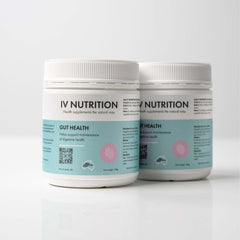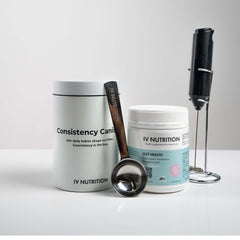Hemorrhoids—often considered a taboo topic—are surprisingly common, affecting millions of adults each year. Though they’re typically viewed as a localized issue, the development and persistence of hemorrhoids are often deeply connected to gut health. A well-functioning digestive system is critical for preventing straining, inflammation, constipation, and other gastrointestinal issues that lead directly to hemorrhoidal flare-ups.
In this science-backed and clinically grounded article, we’ll explore the lesser-known link between hemorrhoids and gut health, the role of diet and digestion in vascular function, and how targeted interventions—such as hydration, lifestyle modifications, and prebiotic fiber supplementation—can provide relief and support long-term prevention.
We’ll also introduce a natural, gentle way to support your gut and reduce hemorrhoid risk: IV Nutrition’s virgin-manufactured sugarcane prebiotic fiber, which is available with 100% off your first tub when you subscribe. Click here to redeem the offer.
Table of Contents
-
What Are Hemorrhoids?
-
The Gut-Hemorrhoid Connection
-
Common Digestive Triggers for Hemorrhoids
-
The Role of Fiber in Preventing Hemorrhoids
-
Prebiotics vs. Probiotics: What You Actually Need
-
Spotlight: Sugarcane Prebiotic Fiber by IV Nutrition
-
Foods to Eat (and Avoid) for Hemorrhoid and Gut Relief
-
Lifestyle and Habits That Support Gut-Vascular Health
-
How Long Does it Take to Improve Gut-Related Hemorrhoids?
-
Conclusion: Heal from the Inside Out
1. What Are Hemorrhoids?
Hemorrhoids are swollen veins located in the lower rectum and anus. They can occur internally (inside the rectal canal) or externally (under the skin around the anus). Symptoms may include:
-
Pain or discomfort, especially during bowel movements
-
Itching or irritation around the anus
-
Swelling or a noticeable lump near the anus
-
Bleeding, typically bright red during or after defecation
While often non-serious, they can significantly impact quality of life and are frequently caused or worsened by digestive dysfunction.
2. The Gut-Hemorrhoid Connection
Most hemorrhoids develop due to chronic straining during bowel movements, which is usually caused by constipation, poor stool form, or incomplete evacuation. At the heart of these issues? The gut.
Here’s how poor gut health contributes to hemorrhoids:
-
Constipation and hard stools increase rectal pressure, weakening veins
-
Inflammation in the gut affects vascular tone and tissue resilience
-
Gut dysbiosis can slow transit time, further aggravating straining
-
Lack of fiber reduces stool bulk and moisture, making defecation more difficult
Maintaining a healthy gut microbiome—rich in beneficial bacteria, supported by adequate fiber and hydration—creates the conditions for soft, regular bowel movements and decreased hemorrhoid risk.
3. Common Digestive Triggers for Hemorrhoids
Multiple gut-related issues can increase your risk of developing or worsening hemorrhoids:
1. Low-Fiber Diet
A diet lacking in soluble and insoluble fiber contributes to small, hard stools and irregular motility.
2. Dysbiosis (Imbalanced Gut Flora)
When harmful bacteria outnumber beneficial ones, it can slow transit time and increase inflammation throughout the GI tract, indirectly pressuring the rectal veins.
3. Poor Hydration
Without enough water, stool becomes dry and difficult to pass, contributing to straining.
4. Inflammation in the GI Tract
Inflamed intestinal walls often lead to gut permeability and inflammatory signals throughout the lower GI tract—sometimes weakening rectal tissues.
5. Overuse of Laxatives
While laxatives may offer temporary relief, long-term use disrupts the natural rhythm of digestion and weakens bowel function.
4. The Role of Fiber in Preventing Hemorrhoids
Fiber is one of the most critical nutritional elements in both gut health and hemorrhoid prevention.
How fiber helps:
-
Bulks up stool so it passes more easily through the colon
-
Retains water in the digestive tract, keeping stool soft
-
Feeds beneficial bacteria, which support motility and reduce inflammation
-
Improves bowel regularity, decreasing pressure on rectal veins
There are two types of fiber to understand:
| Type | Function | Sources |
|---|---|---|
| Soluble | Forms a gel-like substance, softens stool | Oats, beans, apples, flaxseed |
| Insoluble | Adds bulk and speeds up transit | Whole grains, vegetables |
Many people focus solely on insoluble fiber (like bran), but soluble prebiotic fiber is often the missing link in long-term gut and hemorrhoid relief.
5. Prebiotics vs. Probiotics: What You Actually Need
While probiotics have gained popularity, prebiotics are often more essential for gut health—especially for those dealing with hemorrhoids.
What Are Prebiotics?
Prebiotics are non-digestible plant fibers that serve as food for your beneficial gut bacteria. By feeding these microbes, prebiotics help improve digestion, reduce inflammation, and regulate bowel movements—crucial for preventing hemorrhoids.
Key Benefits of Prebiotics:
-
Increase production of short-chain fatty acids (SCFAs) like butyrate, which reduce inflammation and promote regularity
-
Restore healthy microbial balance
-
Help rebuild a damaged or sluggish gut environment
-
Reduce gut transit time without harsh laxatives
Now let’s look at a gentle, natural source of prebiotic support.
6. Spotlight: Sugarcane Prebiotic Fiber by IV Nutrition
One of the most advanced prebiotic fiber options now available is IV Nutrition’s Virgin-Manufactured Sugarcane Prebiotic Fiber—a unique, naturally sourced supplement designed to gently improve gut health and support vascular wellness.
Why Sugarcane-Derived Fiber?
-
Virgin-extracted: Maintains full nutritional integrity, unlike over-processed fiber powders
-
Rich in fermentable fiber: Fuels beneficial bacteria without bloating
-
GMO-free and 100% natural: Ideal for sensitive digestion
-
Supports smoother, easier bowel movements: Less strain, less risk of hemorrhoids
By naturally enhancing microbial health and improving stool quality, this fiber addresses one of the core causes of hemorrhoids—gut dysfunction.
Special Offer: First Tub 100% Free
For a limited time, IV Nutrition is offering 100% off your first tub when you subscribe. It’s a simple, effective way to jump-start your digestive reset and reduce your risk of hemorrhoids at the source.
→ Click here to claim your free prebiotic fiber tub
7. Foods to Eat (and Avoid) for Hemorrhoid and Gut Relief
Best Gut-Healthy, Anti-Hemorrhoid Foods:
| Category | Examples |
|---|---|
| Prebiotic-rich | Garlic, leeks, bananas, onions |
| High-fiber | Lentils, oats, carrots, leafy greens |
| Hydrating fruits | Berries, oranges, watermelon |
| Anti-inflammatory | Turmeric, ginger, wild-caught salmon |
| Fermented foods | Sauerkraut, kefir, miso, yogurt |
Foods That May Worsen Gut Issues and Hemorrhoids:
| Avoid or Limit | Reason |
|---|---|
| Refined sugars | Promote dysbiosis and inflammation |
| Fried foods | Increase transit time and irritation |
| Alcohol | Dehydrates and weakens tissue walls |
| Low-fiber snacks | Cause sluggish digestion |
| Spicy foods (during flare-ups) | Can irritate sensitive tissues |
8. Lifestyle and Habits That Support Gut-Vascular Health
Beyond diet, your daily habits play a vital role in hemorrhoid prevention and gut health restoration.
1. Hydrate Intentionally
Aim for at least 8–10 cups of water daily. Hydration keeps stool soft and digestion efficient.
2. Move Your Body
Exercise supports natural peristalsis (intestinal movement) and helps prevent stagnation in the colon.
3. Don’t Delay the Urge
Waiting too long to have a bowel movement increases rectal pressure and encourages hemorrhoid formation.
4. Elevate Your Feet on the Toilet
Using a footstool mimics a squatting position, aligning the rectum for easier evacuation.
5. Manage Stress
Stress hormones can slow digestion and contribute to gut inflammation. Use breathwork, yoga, or even daily walks to manage stress load.
9. How Long Does it Take to Improve Gut-Related Hemorrhoids?
Most people begin to notice relief within 2 to 4 weeks of consistent gut support, including:
-
Regular hydration
-
Daily prebiotic fiber intake
-
Elimination of gut-irritating foods
-
Physical activity and stress reduction
More severe cases or long-standing gut dysfunction may require 8 to 12 weeks of commitment to fully normalize digestion and reduce flare-ups.
Consistency is key. The gut is capable of healing—especially when given the right building blocks, like prebiotic fiber and whole-food nutrients.
10. Conclusion: Heal from the Inside Out
Hemorrhoids are not just a localized problem—they’re often the external symptom of internal digestive dysfunction. By improving gut health, you can address the underlying causes of hemorrhoidal pain, reduce recurrence, and create a foundation for long-term wellness.
Your first step? Support your gut microbiome with targeted prebiotic nutrition.
IV Nutrition’s Virgin-Manufactured Sugarcane Prebiotic Fiber is a gentle, natural, and clinically aligned way to:
-
Promote regular, strain-free bowel movements
-
Nourish your gut microbiome
-
Reduce inflammation and vascular stress
-
Prevent future flare-ups
And right now, your first tub is 100% free when you subscribe.





